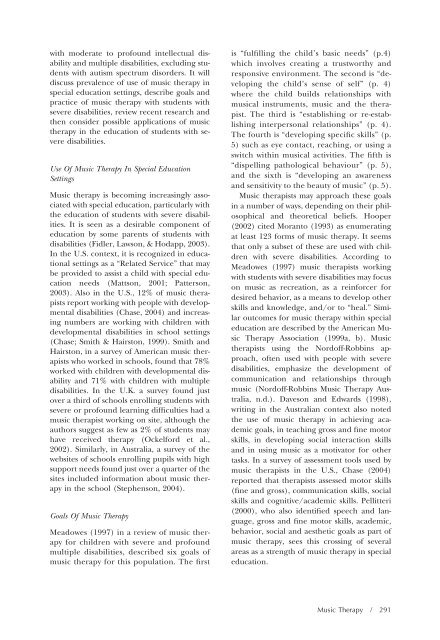Music Therapy and the Education of Students with Severe Disabilities
Music Therapy and the Education of Students with Severe Disabilities
Music Therapy and the Education of Students with Severe Disabilities
You also want an ePaper? Increase the reach of your titles
YUMPU automatically turns print PDFs into web optimized ePapers that Google loves.
<strong>with</strong> moderate to pr<strong>of</strong>ound intellectual disability<br />
<strong>and</strong> multiple disabilities, excluding students<br />
<strong>with</strong> autism spectrum disorders. It will<br />
discuss prevalence <strong>of</strong> use <strong>of</strong> music <strong>the</strong>rapy in<br />
special education settings, describe goals <strong>and</strong><br />
practice <strong>of</strong> music <strong>the</strong>rapy <strong>with</strong> students <strong>with</strong><br />
severe disabilities, review recent research <strong>and</strong><br />
<strong>the</strong>n consider possible applications <strong>of</strong> music<br />
<strong>the</strong>rapy in <strong>the</strong> education <strong>of</strong> students <strong>with</strong> severe<br />
disabilities.<br />
Use Of <strong>Music</strong> <strong>Therapy</strong> In Special <strong>Education</strong><br />
Settings<br />
<strong>Music</strong> <strong>the</strong>rapy is becoming increasingly associated<br />
<strong>with</strong> special education, particularly <strong>with</strong><br />
<strong>the</strong> education <strong>of</strong> students <strong>with</strong> severe disabilities.<br />
It is seen as a desirable component <strong>of</strong><br />
education by some parents <strong>of</strong> students <strong>with</strong><br />
disabilities (Fidler, Lawson, & Hodapp, 2003).<br />
In <strong>the</strong> U.S. context, it is recognized in educational<br />
settings as a “Related Service” that may<br />
be provided to assist a child <strong>with</strong> special education<br />
needs (Mattson, 2001; Patterson,<br />
2003). Also in <strong>the</strong> U.S., 12% <strong>of</strong> music <strong>the</strong>rapists<br />
report working <strong>with</strong> people <strong>with</strong> developmental<br />
disabilities (Chase, 2004) <strong>and</strong> increasing<br />
numbers are working <strong>with</strong> children <strong>with</strong><br />
developmental disabilities in school settings<br />
(Chase; Smith & Hairston, 1999). Smith <strong>and</strong><br />
Hairston, in a survey <strong>of</strong> American music <strong>the</strong>rapists<br />
who worked in schools, found that 78%<br />
worked <strong>with</strong> children <strong>with</strong> developmental disability<br />
<strong>and</strong> 71% <strong>with</strong> children <strong>with</strong> multiple<br />
disabilities. In <strong>the</strong> U.K. a survey found just<br />
over a third <strong>of</strong> schools enrolling students <strong>with</strong><br />
severe or pr<strong>of</strong>ound learning difficulties had a<br />
music <strong>the</strong>rapist working on site, although <strong>the</strong><br />
authors suggest as few as 2% <strong>of</strong> students may<br />
have received <strong>the</strong>rapy (Ockelford et al.,<br />
2002). Similarly, in Australia, a survey <strong>of</strong> <strong>the</strong><br />
websites <strong>of</strong> schools enrolling pupils <strong>with</strong> high<br />
support needs found just over a quarter <strong>of</strong> <strong>the</strong><br />
sites included information about music <strong>the</strong>rapy<br />
in <strong>the</strong> school (Stephenson, 2004).<br />
Goals Of <strong>Music</strong> <strong>Therapy</strong><br />
Meadowes (1997) in a review <strong>of</strong> music <strong>the</strong>rapy<br />
for children <strong>with</strong> severe <strong>and</strong> pr<strong>of</strong>ound<br />
multiple disabilities, described six goals <strong>of</strong><br />
music <strong>the</strong>rapy for this population. The first<br />
is “fulfilling <strong>the</strong> child’s basic needs” (p.4)<br />
which involves creating a trustworthy <strong>and</strong><br />
responsive environment. The second is “developing<br />
<strong>the</strong> child’s sense <strong>of</strong> self” (p. 4)<br />
where <strong>the</strong> child builds relationships <strong>with</strong><br />
musical instruments, music <strong>and</strong> <strong>the</strong> <strong>the</strong>rapist.<br />
The third is “establishing or re-establishing<br />
interpersonal relationships” (p. 4).<br />
The fourth is “developing specific skills” (p.<br />
5) such as eye contact, reaching, or using a<br />
switch <strong>with</strong>in musical activities. The fifth is<br />
“dispelling pathological behaviour” (p. 5),<br />
<strong>and</strong> <strong>the</strong> sixth is “developing an awareness<br />
<strong>and</strong> sensitivity to <strong>the</strong> beauty <strong>of</strong> music” (p. 5).<br />
<strong>Music</strong> <strong>the</strong>rapists may approach <strong>the</strong>se goals<br />
in a number <strong>of</strong> ways, depending on <strong>the</strong>ir philosophical<br />
<strong>and</strong> <strong>the</strong>oretical beliefs. Hooper<br />
(2002) cited Moranto (1993) as enumerating<br />
at least 123 forms <strong>of</strong> music <strong>the</strong>rapy. It seems<br />
that only a subset <strong>of</strong> <strong>the</strong>se are used <strong>with</strong> children<br />
<strong>with</strong> severe disabilities. According to<br />
Meadowes (1997) music <strong>the</strong>rapists working<br />
<strong>with</strong> students <strong>with</strong> severe disabilities may focus<br />
on music as recreation, as a reinforcer for<br />
desired behavior, as a means to develop o<strong>the</strong>r<br />
skills <strong>and</strong> knowledge, <strong>and</strong>/or to “heal.” Similar<br />
outcomes for music <strong>the</strong>rapy <strong>with</strong>in special<br />
education are described by <strong>the</strong> American <strong>Music</strong><br />
<strong>Therapy</strong> Association (1999a, b). <strong>Music</strong><br />
<strong>the</strong>rapists using <strong>the</strong> Nord<strong>of</strong>f-Robbins approach,<br />
<strong>of</strong>ten used <strong>with</strong> people <strong>with</strong> severe<br />
disabilities, emphasize <strong>the</strong> development <strong>of</strong><br />
communication <strong>and</strong> relationships through<br />
music (Nord<strong>of</strong>f-Robbins <strong>Music</strong> <strong>Therapy</strong> Australia,<br />
n.d.). Daveson <strong>and</strong> Edwards (1998),<br />
writing in <strong>the</strong> Australian context also noted<br />
<strong>the</strong> use <strong>of</strong> music <strong>the</strong>rapy in achieving academic<br />
goals, in teaching gross <strong>and</strong> fine motor<br />
skills, in developing social interaction skills<br />
<strong>and</strong> in using music as a motivator for o<strong>the</strong>r<br />
tasks. In a survey <strong>of</strong> assessment tools used by<br />
music <strong>the</strong>rapists in <strong>the</strong> U.S., Chase (2004)<br />
reported that <strong>the</strong>rapists assessed motor skills<br />
(fine <strong>and</strong> gross), communication skills, social<br />
skills <strong>and</strong> cognitive/academic skills. Pellitteri<br />
(2000), who also identified speech <strong>and</strong> language,<br />
gross <strong>and</strong> fine motor skills, academic,<br />
behavior, social <strong>and</strong> aes<strong>the</strong>tic goals as part <strong>of</strong><br />
music <strong>the</strong>rapy, sees this crossing <strong>of</strong> several<br />
areas as a strength <strong>of</strong> music <strong>the</strong>rapy in special<br />
education.<br />
<strong>Music</strong> <strong>Therapy</strong> / 291
















